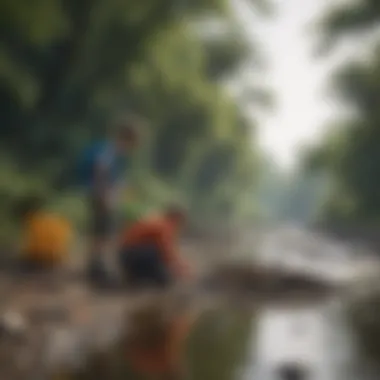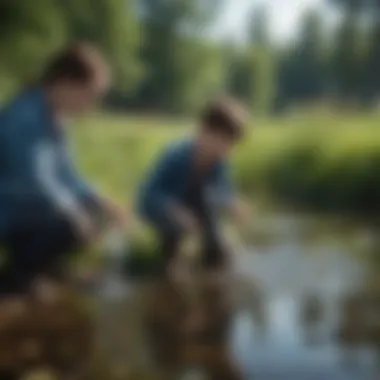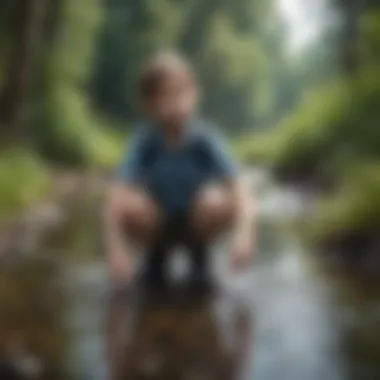Engage Kids in Interactive Water Pollution Activities for Earth Day Celebration


Nature Topic Overview
As we delve into the intricate world of water pollution activities for Earth Day, it is essential to grasp the pivotal role that understanding environmental conservation plays in shaping young minds. From highlighting the detrimental effects of water pollution to instilling a sense of responsibility, these activities are tailored to engage children aged 5-12 in a meaningful exploration of the importance of safeguarding our planet's water bodies.
Fun Facts and Trivia
Engaging young learners with water pollution activities can be enriched by intriguing tidbits such as the impact of plastic waste on marine life or the significance of wetlands in filtering water. Interactive elements like visual representations of polluted waterways paired with before-and-after scenarios can spark curiosity and facilitate a deeper understanding of the consequences of pollution.
Wildlife Explorations
Diving into water pollution unveils a world where species like fish, turtles, and birds are intricately tied to aquatic ecosystems. Learning about the adaptation of aquatic wildlife to changing water conditions can captivate young audiences. Introducing fun quizzes or puzzles on identifying aquatic species further enhances engagement and fosters a connection with nature.
Environmental Awareness
Instilling environmental awareness goes beyond facts and figures; it involves imparting a sense of stewardship towards nature. By underscoring the importance of conservation and sustainability in relation to water pollution, children can grasp the real-world implications of their actions. Practical tips on reducing plastic usage or conserving water empower young minds to take tangible steps towards protecting the environment.
DIY Nature Activities
Hands-on experiences are paramount in reinforcing learning, and DIY nature activities provide the perfect avenue for practical application. Craft projects like creating a mini ocean ecosystem or conducting water filtration experiments not only entertain but also educate. Encouraging outdoor explorations, such as pond clean-ups or beach scavenger hunts, enables children to connect theory with real-world experiences, solidifying their understanding of water pollution issues.
Introduction to Earth Day
Earth Day holds a vital place in the realm of environmental conservation. It serves as a beacon guiding humanity towards a sustainable future. Recognized globally, Earth Day resonates with individuals, communities, and nations, uniting them in a common goal of preserving our planet. This article aims to delve into the core essence of Earth Day, exploring its significance in igniting the spark of environmental consciousness among the younger generation.
Significance of Earth Day
Historical Background
Earth Day traces its origins back to the grassroots movement of the 1970s, sparked by the urgent need to address environmental concerns. Its historical foundation reflects the spirit of activism and unity, epitomizing the power of collective action in safeguarding our ecosystems. The legacy of historical protests, such as the first Earth Day in 1970, continues to inspire modern environmental movements, underscoring the enduring relevance of raising eco-awareness.
Global Impact
The global impact of Earth Day transcends borders, fostering a sense of shared responsibility towards the planet. By catalyzing discussions on critical environmental issues, Earth Day serves as a catalyst for policy reforms, sustainable practices, and advocacy for sustainable development. Its resonance on a global scale underscores the significance of collaborative efforts in tackling pressing ecological challenges.
Youth Involvement
Youth involvement in Earth Day activities plays an instrumental role in shaping the future of environmental stewardship. Empowering the younger generation to actively participate in conservation initiatives cultivates a sense of ownership and responsibility towards environmental protection. By engaging youth in eco-conscious practices, Earth Day nurtures a generation of environmental advocates committed to safeguarding our natural resources.
Objective of Earth Day Activities
Raising Awareness
Raising awareness stands as a cornerstone objective of Earth Day activities, fueling discussions on environmental issues and inspiring collective action. By shedding light on pressing ecological concerns, Earth Day activities aim to educate diverse audiences, instilling a sense of urgency and responsibility towards sustainable practices.
Promoting Sustainability


Promoting sustainability lies at the heart of Earth Day initiatives, emphasizing the importance of adopting eco-friendly habits and reducing environmental impact. Through sustainable practices and advocacy, Earth Day endeavors to catalyze long-term changes in community behaviors, paving the way for a greener, more resilient future.
Instilling Environmental Values
Instilling environmental values forms a fundamental aspect of Earth Day activities, nurturing a culture of respect and care for the environment. By imparting ethical principles and environmental ethos, Earth Day fosters a deep-seated appreciation for nature and encourages individuals to become conscientious stewards of the earth.
Theme for Current Earth Day
Water Conservation
Water conservation emerges as a pivotal theme for the current Earth Day, highlighting the critical importance of preserving this precious resource. By promoting water-saving practices and advocating for water resource management, Earth Day underscores the intrinsic link between water conservation and environmental sustainability.
Combatting Water Pollution
The theme of combatting water pollution underscores the urgent need to address contamination threats to water bodies worldwide. Through raising awareness, implementing pollution control measures, and advocating for policy changes, Earth Day strives to combat water pollution and protect aquatic ecosystems for future generations.
Preserving Aquatic Ecosystems
Preserving aquatic ecosystems stands as a focal point of Earth Day initiatives, emphasizing the delicate balance of marine life and water habitats. By advocating for conservation measures, habitat protection, and sustainable fishing practices, Earth Day endeavors to safeguard the biodiversity and ecological health of aquatic environments.
Understanding Water Pollution
In this significant section of the article, the focus is on delving deep into the complexities of water pollution and its implications. Understanding the nuances of water pollution is crucial in comprehending the dire need for conservation efforts, especially in the context of Earth Day activities tailored for children aged 5-12. By highlighting the causes, effects, and preventive measures of water pollution, this section aims to instill a profound sense of environmental responsibility in young minds, nurturing them as stewards of the planet.
Causes of Water Pollution
Industrial Discharges
Industrial discharges, a key contributor to water pollution, play a pivotal role in contaminating aquatic ecosystems. The unregulated release of harmful chemicals and substances from industries poses a severe threat to water bodies, impacting both marine life and human health. Understanding the prominence of industrial discharges is essential in addressing the root causes of water pollution, emphasizing the need for stringent regulations and sustainable practices to mitigate their detrimental effects.
Agricultural Runoff
Agricultural runoff, arising from the excessive use of fertilizers and pesticides in farming practices, significantly degrades water quality. The runoff carries pollutants like nitrogen and phosphorus into water sources, leading to eutrophication and algae bloom, posing threats to aquatic organisms. Exploring the impact of agricultural runoff sheds light on the intricate link between agricultural activities and water pollution, underscoring the importance of eco-friendly farming methods for safeguarding water ecosystems.
Improper Waste Disposal
Improper waste disposal, whether in landfills or water bodies, brings forth a host of environmental hazards. Discarded plastics, chemicals, and other non-biodegradable waste accumulate in water sources, polluting them and causing widespread harm to aquatic life. Highlighting the repercussions of improper waste disposal underscores the critical need for waste management strategies, recycling initiatives, and public awareness campaigns to curb water pollution effectively.
Effects of Water Pollution
Impact on Aquatic Life
Water pollution exerts a detrimental impact on aquatic life, disrupting ecosystems and endangering species survival. Contaminants like heavy metals and toxins alter water chemistry, leading to fish kills, declining biodiversity, and habitat destruction. Understanding the intricate relationship between water quality and aquatic biodiversity emphasizes the urgency of conservation efforts to protect vulnerable marine organisms from the perils of pollution.
Threat to Human Health


The contamination of water sources poses a direct threat to human health, potentially causing waterborne diseases, infections, and long-term health complications. Consuming polluted water or coming into contact with contaminated water bodies increases the risk of illnesses, necessitating stringent measures to ensure access to clean and safe drinking water. Exploring the nexus between water pollution and human health underscores the critical need for water sanitation practices and pollution control strategies to safeguard public well-being.
Ecosystem Degradation
Ecosystem degradation resulting from water pollution disrupts the delicate balance of natural systems, endangering biodiversity and ecological stability. Pollutants degrade habitats, reduce water quality, and impair ecosystem services, leading to cascading effects on flora and fauna. Examining the repercussions of ecosystem degradation underscores the interconnectedness of all living organisms and the imperative of preserving healthy ecosystems through pollution prevention and conservation initiatives.
Earth Day Activities for Kids
Interactive Water Pollution Experiments
DIY Water Filtration
DIY Water Filtration is a hands-on experiment where kids create their own water filtration system using everyday materials. This activity not only educates children about the importance of clean water but also empowers them to explore practical solutions to addressing water pollution. The key characteristic of DIY Water Filtration lies in its simplicity and effectiveness in demonstrating how impurities can be removed from water. This experiment is a popular choice for its affordability and educational value, providing a tangible way for kids to grasp concepts of filtration and purification.
Oil Spill Simulation
Oil Spill Simulation immerses children in a scenario where they simulate the effects of an oil spill on water bodies. This activity highlights the disastrous impact of oil pollution on aquatic ecosystems and encourages critical thinking about environmental disasters. The key characteristic of Oil Spill Simulation is its ability to simulate real-world consequences visually and experientially, making it an impactful choice for raising awareness about oil pollution. Although this activity effectively conveys the severity of oil spills, it may require supervision due to the use of certain materials.
Acid Rain Investigation
Acid Rain Investigation involves studying the effects of acid rain on various materials, emphasizing the harmful consequences of pollution on the environment. This experiment enables kids to observe firsthand the corrosive nature of acid rain and its implications for ecosystems. The unique feature of Acid Rain Investigation is its focus on demonstrating the chemical reactions caused by acidic precipitation, fostering a deeper understanding of environmental chemistry. While this activity is educational and engaging, it requires proper safety precautions due to the use of acids.
Art and Craft Projects
Trash to Treasure
Trash to Treasure inspires children to repurpose recyclable materials into art pieces, highlighting the concept of upcycling and promoting sustainable practices. This project encourages creativity and resourcefulness, emphasizing the importance of waste reduction and environmental consciousness. The key characteristic of Trash to Treasure is its transformative nature, turning ordinary objects into beautiful creations while advocating for eco-friendly behaviors. This hands-on activity fosters a sense of environmental responsibility and creativity in young learners, making it a valuable addition to Earth Day initiatives.
Ocean Diorama
Ocean Diorama allows kids to create a three-dimensional representation of marine life and habitats, raising awareness about the beauty and fragility of oceans. This art project showcases underwater ecosystems and marine biodiversity, promoting appreciation and conservation of ocean resources. The key characteristic of Ocean Diorama is its immersive and educational nature, offering a visual depiction of underwater worlds to inspire curiosity and respect for marine environments. Despite its artistic appeal, this project requires materials that accurately represent marine ecosystems to convey a realistic portrayal.
Pollution Collage
Pollution Collage engages children in assembling visual artworks using images or materials that reflect the impact of pollution on nature. This project prompts discussions about environmental degradation and human activities that harm terrestrial and aquatic ecosystems. The unique feature of Pollution Collage lies in its ability to evoke emotional responses and provoke thoughts about the consequences of pollution on our planet. While this activity encourages creativity and critical thinking, it also serves as a powerful tool to instigate conversations about environmental stewardship and sustainable practices.
Educational Games and Puzzles
Water Pollution Bingo
Water Pollution Bingo is an interactive game that familiarizes kids with water pollution sources, effects, and preventive measures in a fun and educational way. This game encourages active participation and enhances understanding of key environmental concepts related to water quality. The key characteristic of Water Pollution Bingo is its ability to engage children through gamified learning, making complex environmental topics easily digestible and enjoyable. By incorporating elements of competition and learning, this game promotes knowledge retention and environmental awareness among young participants.
Polluted Aquatic Maze
Polluted Aquatic Maze challenges kids to guide a character through a maze while avoiding polluted areas and reaching a clean water source. This puzzle reinforces the importance of protecting water bodies from contamination and encourages problem-solving skills in a dynamic setting. The key characteristic of Polluted Aquatic Maze is its interactive approach to environmental education, stimulating critical thinking about water pollution issues and solutions. While providing entertainment, this game also imparts valuable lessons on the significance of clean water for ecosystems and human well-being.


Save the River Quiz
Save the River Quiz tests children's knowledge about river ecosystems, water conservation practices, and pollution prevention measures through a quiz format. This educational game prompts players to reflect on their understanding of water resources and inspires them to take action to safeguard rivers and waterways. The unique feature of Save the River Quiz is its informative and engaging format, offering a mix of entertainment and learning outcomes. By challenging players to think critically about environmental issues, this quiz instills a sense of environmental responsibility and encourages continuous learning about water conservation.
Promoting Environmental Awareness
Community Clean-Up Initiatives
Riverbank Cleaning Drive
The Riverbank Cleaning Drive emerges as a crucial initiative within the spectrum of Promoting Environmental Awareness. This focused activity involves mobilizing communities to converge along riverbanks, clearing debris and waste that endanger aquatic ecosystems. Noteworthy for its hands-on approach and tangible impact, the Riverbank Cleaning Drive stands out as a popular choice within this article for its realistic portrayal of environmental conservation efforts. Although demanding physical labor, the simplicity and direct impact of this drive make it a compelling option for nurturing ecological responsibility within participants.
Beach Garbage Collection
In the endeavor to promote environmental awareness, Beach Garbage Collection emerges as a dynamic activity with a profound impact. This initiative involves scouring beaches for discarded waste, preventing marine contamination and safeguarding coastal ecosystems. Distinguished for its effectiveness in highlighting the consequences of improper waste disposal, Beach Garbage Collection is a favored choice in this article for its accessibility and educational value. Despite facing logistical challenges like volume and safety considerations, this activity remains a pivotal tool in educating children about marine conservation and the significance of individual actions in preserving nature.
Lake Restoration Project
Within the realm of Promoting Environmental Awareness, the Lake Restoration Project represents a multifaceted endeavor aimed at revitalizing degraded lake ecosystems. This hands-on project involves tasks such as habitat restoration, water quality improvement, and ecological balance maintenance. Renowned for its comprehensive approach and sustainable impact, the Lake Restoration Project emerges as a top contender in this article for its transformative potential and educational depth. Although resource-intensive and time-consuming, the benefits of engaging children in lake restoration efforts extend beyond immediate results, fostering a lasting commitment to environmental preservation and holistic stewardship.
Wrapping Up Earth Day Activities
Wrapping Up Earth Day Activities marks a crucial phase in this comprehensive guide, offering a chance to reflect on the impact of the activities and reinforce the lessons learned throughout. By engaging in this segment, participants can consolidate their understanding of environmental conservation principles and solidify their commitment to preserving water bodies. This section provides a structured approach to concluding Earth Day initiatives, ensuring that the awareness and values instilled during the activities are retained and translated into actionable steps for the future.
Reflection and Discussion
Sharing Learnings
When it comes to Sharing Learnings, this aspect plays a pivotal role in reinforcing the key messages communicated during the Earth Day activities. By reflecting on and sharing what they have learned, participants can internalize the importance of water conservation and pollution prevention. Sharing Learnings promotes a sense of community and collaboration, empowering individuals to take collective responsibility for environmental stewardship. Its interactive nature fosters engagement and encourages openness to new ideas and perspectives, making it an invaluable component of Earth Day initiatives.
Future Action Plans
Future Action Plans serve as the bridge between awareness and concrete implementation, guiding participants on how to translate their newfound knowledge into practical steps. By creating actionable strategies for continued environmental engagement, individuals can extend the impact of Earth Day activities beyond a one-time event. Future Action Plans empower participants to become advocates for sustainable practices, fostering long-term commitment to protecting our planet for future generations.
Environmental Commitments
Environmental Commitments encapsulate the essence of dedication to ongoing environmental conservation efforts. By committing to specific actions that support sustainability and protect water resources, individuals demonstrate their alignment with the values instilled during Earth Day activities. These commitments serve as a personal pledge to uphold environmental responsibility and serve as a catalyst for broader societal change towards a more sustainable future.
Post-Activity Resources
Reading Recommendations
Incorporating Reading Recommendations into post-activity resources provides participants with additional avenues to deepen their understanding of water pollution and conservation. By recommending relevant literature and educational materials, individuals can continue their learning journey beyond Earth Day. Reading Recommendations offer opportunities for further exploration, allowing participants to gain insights from diverse sources and perspectives, enriching their environmental awareness and knowledge base.
Online Educational Platforms
Online Educational Platforms extend the reach of Earth Day activities by offering interactive and engaging resources for continued learning. Through these platforms, participants can access a wealth of information on water conservation, pollution prevention, and environmental sustainability. Online Educational Platforms provide a flexible learning environment that accommodates varied learning styles and preferences, enhancing the impact of Earth Day initiatives and nurturing a culture of ongoing environmental education.
Water Conservation Tips
Equipping participants with practical Water Conservation Tips empowers them to make everyday choices that contribute to water preservation and sustainability. By integrating simple yet effective tips into post-activity resources, individuals can implement water-saving practices in their daily lives. Water Conservation Tips promote behavior change and reinforce the commitment to environmental responsibility, encouraging sustained efforts towards protecting our precious water resources.







